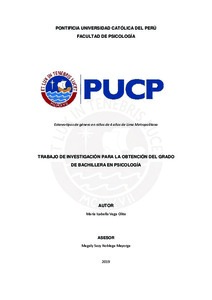| dc.contributor.advisor | Nóblega Mayorga, Magaly Suzy | |
| dc.contributor.author | Vega Olite, María Isabella | |
| dc.date.accessioned | 2020-02-10T17:36:53Z | |
| dc.date.available | 2020-02-10T17:36:53Z | |
| dc.date.created | 2019 | |
| dc.date.issued | 2020-02-10 | |
| dc.identifier.uri | http://hdl.handle.net/20.500.12404/15887 | |
| dc.description.abstract | El objetivo de la presente investigación fue describir los estereotipos de género de los
niños y las niñas de 4 años de Lima Metropolitana. Para ello, se plantearon grupos de discusión
donde se realizaron ciertas actividades con un grupo de niños y con un grupo de niñas, con el
fin de conocer las ideas que tienen respecto a lo masculino y a lo femenino. Además, se realizó
una entrevista a tres de las maestras del aula, con el fin de profundizar respecto a los
estereotipos de género en los niños y las niñas. Luego, se realizó un diseño de análisis
cualitativo y un análisis temático, el cual busca identificar y analizar patrones por temas.
Específicamente, no se identificaron estereotipos de género con características relacionadas a
los gustos y las preferencias, y a la expresión emocional, pero sí se identificaron estereotipos
de género relacionados a las conductas de los hombres y las mujeres. Esto se evidencia en el
discurso y en el juego de los niños y las niñas, y en lo mencionado por las maestras. | es_ES |
| dc.description.abstract | This research aims to describe the gender stereotypes of children of 4 years of Lima,
Peru. For this purpose, we conducted discussion groups where certain activities were developed
with a group of boys and a group of girls, in order to understand believes that girls and boys
have about masculine and feminine. In addition, we conducted an interview with three of the
teachers of the children classroom in order to deepen gender stereotypes among boys and girls.
Then, we did a qualitative analysis and a thematic analysis, which seeks to identify and analyze
patterns by themes. Specifically, no gender stereotypes were identified with characteristics
related to tastes and preferences, and emotional expression, but gender stereotypes related to
the behavior of men and women were identified. This was shown in the discourse and games
of boys and girls, and in what was mentioned by the teachers. | es_ES |
| dc.language.iso | spa | es_ES |
| dc.publisher | Pontificia Universidad Católica del Perú | es_ES |
| dc.rights | info:eu-repo/semantics/openAccess | es_ES |
| dc.rights.uri | http://creativecommons.org/licenses/by-nc-sa/2.5/pe/ | * |
| dc.subject | Niños y género | es_ES |
| dc.subject | Estereotipo (Psicología) | es_ES |
| dc.subject | Femineidad (Psicología) | es_ES |
| dc.subject | Masculinidad (Psicología) | es_ES |
| dc.title | Estereotipos de género en niños de 4 años de Lima Metropolitana | es_ES |
| dc.type | info:eu-repo/semantics/bachelorThesis | es_ES |
| thesis.degree.name | Bachiller en Psicología | es_ES |
| thesis.degree.level | Bachillerato | es_ES |
| thesis.degree.grantor | Pontificia Universidad Católica del Perú. Facultad de Psicología | es_ES |
| thesis.degree.discipline | Psicología | es_ES |
| renati.advisor.dni | 09823932 | |
| renati.advisor.orcid | https://orcid.org/0000-0001-6572-813X | es_ES |
| renati.discipline | 313016 | es_ES |
| renati.level | https://purl.org/pe-repo/renati/level#bachiller | es_ES |
| renati.type | https://purl.org/pe-repo/renati/type#trabajoDeInvestigacion | es_ES |
| dc.publisher.country | PE | es_ES |
| dc.subject.ocde | http://purl.org/pe-repo/ocde/ford#5.01.00 | es_ES |






